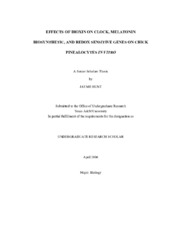Effects of Dioxin on Clock, Melatonin Biosynthetic, and Redox Sensitive Genes on Chick Pinealocytes In Vitro
Abstract
It has been speculated that dioxin treatment can modulate circadian rhythms. Cytochrome P4501A (CYP1A) is strongly induced by the xenobiotic dioxin via activation of arylhydrocarbon receptors within cells. Furthermore, regulation of CYP1A has been shown to occur via redox dependent activity of nuclear factor 1 X-type (NF1X) and cellular redox potential can regulate the circadian clock. As such we hypothesized that exposure to dioxin could affect circadian rhythmicity. We explored the pharmacological effects of the environmental toxicant dioxin on the expression of canonical clock genes, genes involved in melatonin biosynthesis, and putative redox sensitive genes CYP1A5 (an avian ortholog of human CYP1A) and NF1X using quantitative real-time PCR analysis. Dioxin altered the amplitude and phase of the rhythms of clock genes Brain and Muscle ARNT-Like (BMAL) 1 and BMAL2; melatonin biosynthetic pathway genes, hydroxyindole-O-methyltransferase (HIOMT), arylalkylamine-N-acetyltransferase (AANAT), and tryptophan hydroxylase (TrH); and redox sensitive genes, CYP1A5 and NF1X. These results suggest dioxin treatment may uncouple the melatonin biosynthetic pathway from the pineal circadian clock or that the circadian affects of dioxins may be mediated via its affects directly on melatonin synthesis and not directly at the level of the molecular circadian clock.
Citation
Hunt, Jayme (2006). Effects of Dioxin on Clock, Melatonin Biosynthetic, and Redox Sensitive Genes on Chick Pinealocytes In Vitro. Available electronically from https : / /hdl .handle .net /1969 .1 /3649.


